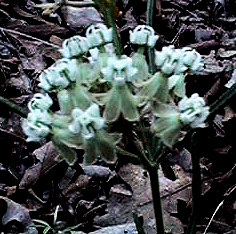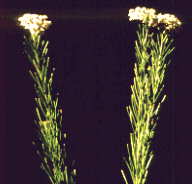
Whorled Milkweed
Family: Milkweed
Size: 1/ 2 inch cluster
Date: Late June

An easily overlooked plant, whorled milkweed probably occurs in every county in North Dakota.The plant grows in open areas throughout most of the eastern United States.
Whorled milkweed is perennial from a shallow root system. Like most milkweeds the plant has milky juice (latex) in the stem and leaves. Plants sometimes are two feet tall, but individuals about half that height are the rule in North Dakota. Leaves of this milkweed are about two inches long and very narrow; they occur in whorls of two to four along the full length of the stem. As in all milkweeds, the flowers are clustered into umbels. Botanists define an umbel as a cluster of flowers in which all the flower stalks (pedicels) arise from the same point. In whorled milkweed, about five to ten tiny white flowers form umbels less than an inch across. Fruit is a pod about three inches long and slightly less than a half inch wide.
This plant seems to be most common on lightly or moderately grazed prairie. Many of the 100 or so pecies of milkweed are used for food, medicine or fiber, but the literature lists no such properties for whorled milkweed.
The milkweed family name (Asclepiadaceae) is dedicated to the Greek god of medicine, Asklepios. Most of the 2400 species in this family are tropical. The specific epithet verticillata means "whorled" in botanical Latin. Whorled milkweed was first described for science by the great Swedish naturalist and father of modern plant taxonomy Carl von Linne (Linnaeus) in 1753.
![]()
 Wildflower
Seed For Sale
Wildflower
Seed For Sale